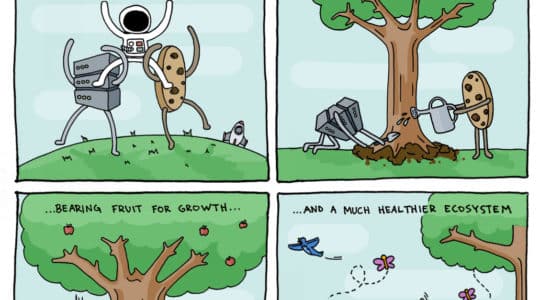Welcome to the newest installment of App Marketing Conversations. In this episode our CEO, Ian Sefferman (@iseff), reviews Apple’s World Wide Developers Conference and what it means for apps. He is joined by Ryan Morel (@ryanmorel) of Gamehouse (@ghpartners) and Robi Ganguly (@rganguly) of Apptentive (@apptentive).
Transcription
Ian Sefferman: Hello, and welcome to another App Marketing Conversations. I am here with Ryan Morel of GameHouse, Robi Ganguly of Apptentive, and I’m Ian Sefferman of MobileDevHQ.
How are you guys doing today?
Ryan Morel: Doing well.
Robi Ganguly: Great.
Ian Sefferman: Good. Hopefully we are all recovering from WWDC. I figured we would go back in time a little bit and talk about some recaps of what were the big events of WWDC, and how marketers can take advantage.
One of the biggest pieces of information was the announcements around both app extensibility and app continuity. Here, I will let you guys explain. Do you want to explain extensibility? Do you want to explain continuity, real quick?
Ryan Morel: Sure.
Robi Ganguly: Yeah. Extensibility, the easiest way to think about that area of functionality is the extensions. The extensions are the ability inside an app to actually share a photo on any number of applications you have installed. Once a new application that has an extension installed is installed on your device, then that functionality can show up at other apps.
Again, take a photo, share it on Instagram. That is an extension that happens seamlessly, and the consumer doesn’t have to think about it, but this is the first time that Apple hasn’t had to blast extensions inside of apps. Previously, you have seen Twitter and Facebook have these things, but now any app maker can have that, which is pretty powerful.
Ian Sefferman: Right, and continuity?
Ryan Morel: Continuity, I think, at the very basic level, is to enable users who have the same app installed on multiple iOS or Mac devices to use them inter-operably.
The simple example that they gave was you’re typing an email on your iPhone; you walk up to your Mac; it gives you a little notification, “Do you want to keep writing this on your Mac?”
As far as I understand, this is sandboxed to Mac apps only for now, but clearly, as Apple does, and we saw it with the keyboards, and with touch ID, that they will get the security, and privacy, and everything right, and then they will roll it out for third parties. I would expect that that will be something that will come available for third-party devs in iOS 9.
Ian Sefferman: Cool. All right, so let’s take a minute or two on each one. Tell me your initial reactions to extensibility. Is it interesting, or not?
Ryan Morel: I think it’s interesting. I think Robi talked a little bit about this before, is that the overall theme was Apple being a little bit more open than they have been in the past. This is an example of that openness, right, where they are giving developers access to more things than they have in the past.
The other one is the keyboards. People were complaining about no third-party keyboards since 2007, and now we have them. This is a clear use case of that, or so to speak.
Ian Sefferman: What are your thoughts on it?
Robi Ganguly: I think it’s about time, right? Like in many ways, you guys have been on iOS devices, and giving me crap about being on Android, but that aspect of Android is so ingrained in my behavior. I do so much sharing, primarily of photos, but also articles that I see that I want to put in a pocket, or tweet, or do something like that.
I just do one button inside whatever app that I am looking at the content in. The fact that you guys haven’t had that, and now it’s going to open it up, means that a bunch of app developers finally will have functionality that is equivalent on both platforms.
I think that is pretty exciting. I think that the consumers are going to start experiencing that, and there are going to be a whole bunch of people who are like, “Wait. I didn’t know you could do this.” It’s just going to show up like magic.
Ryan Morel: Right.
Ian Sefferman: This is sort of my equivalent. You talk a lot about how discovery is broken, but it is only broken for the developers. It is not broken for the consumers. Do you feel like this is actually another instance of that, where consumers actually don’t have any idea that this is broken, but developers and marketers are like, “This is totally broken,” and now they are fixing it?
Ryan Morel: Yeah, I think it is probably like the 80-20 rule. Like, 80% of the people probably don’t care, but the 20% who do, really do. This is something that you would maybe go, and I’m not putting words in your mouth, like, “Now that iOS has this, I may consider switching,” where before you would be like, “No, because of this particular use case that it doesn’t enable.” I have a hard time imagining like how I am personally going to use it, but I am sure that is what developers are for, right? They will come up with a whole bunch of cool stuff.
Ian Sefferman: All right, so talk about continuity. What are your reactions to the continuity stuff?
Robi Ganguly: That was one of the things during the keynote where I think a bunch of people just gasped. They were like, “Wow, that is really impressive.” I think the thing about it that is amazing is, if it works as seamlessly as it does in the demo that they show, it gives a lot of people a reason to have just iOS and MAC OS 10 devices around, because that hand-off was so cool.
I could see that in an enterprise, in particular, being actually a really under-appreciated feature, but something that is really useful. You go from a meeting; you are on your iPad, and then you sit down at your desktop and your notes are synced to your email. You don’t have to sync them. That just seems like a perfect use case that they have on the horizontal.
Ryan Morel: Yeah, the other thing I would add there is, this feels like an underground swipe, an attempt to really move fast into the smart home, considering they are using low-energy Bluetooth for this, and developers only have to go for one platform. You can see the scenario where, “Oh, great, now I walk in and my smart home recognizes that my iOS device is here, and all this stuff just happens,” which is harder on Android, given the fragmentation of OS systems. You can see them taking that to all the smart home developers, right, the clever guys, and going, “You only have to build this one app.” I think it is pretty interesting for the long-term developer ecosystem, and all the Internet of things, stuff that they are going to try to do.
Robi Ganguly: The other thing that I think it also lays the groundwork for is, I think we saw part of OSX was moving to a design look and feel that felt more iOS-y than anything, and then add in continuity and it almost felt like they were sort of starting to lay that groundwork for a time period, ten years out, or whatever it is, where I can essentially walk up to a monitor. My phone is my computer, but I get to use it as a different form or factor right there. I’m doing work on my phone when there is no monitor and keyboard available. Then all of sudden I hit a monitor and keyboard, and now I can do it on a big screen, right?
Ian Sefferman: Yeah.
Robi Ganguly: It feels like they are trying to converge that world. We are obviously a ways off, but it sort of lays that groundwork for it.
Ian Sefferman: Yeah. Is there anything that marketers should be thinking about today, based on these announcements?
Robi Ganguly: I think the area to dig in to would be extensions. Just thinking about, if you are an app that has content-sharing capabilities, or saving capabilities or things along those lines, like experimenting with extensions is probably a very useful place to invest time and effort.
Ryan Morel: Yeah, I would say the same thing, especially as it may result in additional opportunities for discovery for developers. You can see — I’m making this up, so I have no idea if this is possible — but for games specifically, is it possible to do a little mini-game extensions, and have them apply it in other pieces of content? That is pretty cool. I think that is clearly an area, and that goes in line with the widget-type notifications, the interactive notifications, which also kind of feel similar to the extensions. How can you use those in conjunction with extensions to drive engagement around?
Ian Sefferman: Yeah.
Robi Ganguly: Absolutely.
Ian Sefferman: All right. Thanks, everybody, for watching. Be sure to “like” this video on YouTube, subscribe to our channel, and watch the other segments. Thanks.
Author
Becky is the Senior Content Marketing Manager at TUNE. Before TUNE, she led a variety of marketing and communications projects at San Francisco startups. Becky received her bachelor's degree in English from Wake Forest University. After living nearly a decade in San Francisco and Seattle, she has returned to her home of Charleston, SC, where you can find her enjoying the sun and salt water with her family.




Leave a Reply
You must be logged in to post a comment.